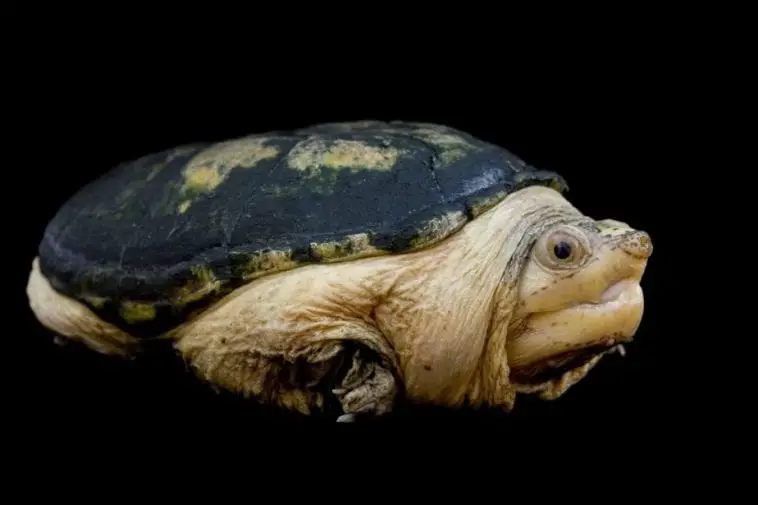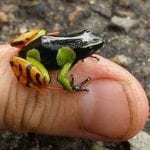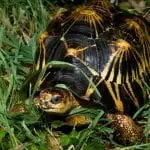Overview
What is this creature? With this question, there are two sides. One side says Claudius is a type of monotypic staurotypine musk turtle, which is an ally to the two species of the giant musk turtle from the genus Staurotypus. While the other side says, this turtle is a kinosternine musk turtle from the smaller and mud and musk turtles of Kinosternon and Sternotherus. Regardless of whatever it is, this turtle Claudius Angustatus having the common name Narrow-Bridged Musk Turtle is simply interesting.
Description

An adult Claudius grows 4 to 6 ½ inches while averagely, most of them are 4 ½ to 5 inches. This turtle’s bridge is narrower compared to the bridges of other turtles. A bridge is the narrow bit of shell which connects the carapace and plastron. In the case of this turtle, the connector is so narrow. In addition, it has ligament instead of a rigid shell.
In terms of behavior, this turtle is aggressive and nasty. It can bite when it is caught first. After being captive, it will be mellow and let itself be handled without a snap. It aestivates in burrows a distance from the water. It could be seen in creeks, shallow river ridges, oxbows, and ponds. They have a preference for bodies of water with muddy bottoms. When in pursuit of prey, this turtle can become an ambush and wait for the predator. It positions itself in a strategic position and lies quietly with its wide-open mouth then snaps anything furiously that bumps into its mouth.
Physically, they are equipped with powerful jaws that are used. The carapace’s color varies. It comes in olive, black, olive horn and olive-gray. It tends to have markings outward. The scute sutures come darker than the surrounding shell. The tiny plastron, as well as the bridges, are in white or pale gray. Ventrally, their skin is white to light gray, while the dorsal surfaces of the neck, tail, legs, and head are olive-charcoal or darker gray.
It is either flecked or peppered, having darker spots. Their mandibles are light having vertical barring or darker spots. Their upper mandible is tricuspid while the bottom is medially and strongly hooked. Male’s head is larger than that of the female. Again their jaws are quite strong. They use their jaws to defend themselves or when looking for food. Their toes are webbed. In terms of the tail, females have shorter ones, while the male’s tail is long, very stout, and tipped having horny scale.
Food
They are carnivorous. They also eat snails, thawed fuzzy mice, minnows, and other prepared food. It takes considerable food amounts to make them feel satisfied. Be careful where you put your fingers. Due to their eagerness when eating, they roar to their food’s surface and elevate their anterior shell. Having a long neck makes their feeding response fast and can strike hard.
Enclosure

For the hatchlings, keep a single individual in a plastic shoebox that is clean and small. If given the right diet, they can grow so fast that you need to move them to a bigger box, then move again to a 10-gallon tank, then eventually to an aquarium of 20 gallons having water of 10 inches and landing space.
They are bottom dwellers. They love a lot of space. If possible, move them to a 125-gallon tank that is 2ft by 6ft by 18 inches. Fill the tank with 10 inches conditioned the water with large driftwood chunks and a 6 inches deep sand for the females nesting area. Put two water filters for current and water clarity. Keep the water’s temperature at 78 to 83 F. Put a basking light above the driftwood.
They don’t swim continually except for basking breaks. As they get familiar with their tank, they will clamber on top of the driftwood and back later. They sprawl out with their neck and limbs extended for almost an hour.
Egg Laying and Incubation

There are three forms of sex determination. In the two forms, in the 2nd-trimester nest temperature is used to determine sex. The third form uses genetically determined sex. Temperature sensitivity is involved. It is called the thermosensitive period. It means lower incubation temperatures of the TSD species produce males, whereas the higher incubation temperature gives rise to the females.
Distribution
These turtles range at low elevations, like the central Veracruz and the northern Oaxaca southward, as well as northern Guatemala and Belize, excluding the Yucatán Peninsula.
Habitat
They live in areas having flooded grasslands seasonally and shallow bodies of water having soft bottoms, namely small streams, ponds, and marshes. They choose shallow waters to be away from crocodiles. Sometimes it is on land and aestivates in underground burrows in the dry season.
Natural History
Their nesting happens onset in November until February with several hutches. Usually, their clutch is 2-3. The mother turtle does not dig a pit. She then lays her eggs on or in vegetation. The incubation takes long from 95-229 days. The hatchlings measure 35 mm in their carapace length, having three developed keels. Their carapaces are black or dark brown while their plastron is yellow.
Availability
Captive-bred Claudius is available to hobbyists. The price depends on the carapacial pattern and size. Males are likely to be more expensive than females.
Facts
- Stinkpots are turtle species that are small and come in various colors like gray, brown, and black. They possess a highly domed shell that covers their bodies. They weigh averagely from 600 to 603 grams.
- Their legs are short while long necks come out. Males are females that can be identified via their tails. Males have longer tails. Their heads are triangular and have a pointed snout beak.
- Their plastrons are small for leg protection. Their tongues are tiny that is covered with bud-like papillae. This helps them to breathe under the water.
- They are active in warm weather but inactive in cold seasons.
- Their breeding starts in spring. Their eggs are elliptical and hard.
Predators
Their predators are always an eye on them from the time they finish laying eggs. Most predators are vultures and crows. They eat the eggs before they are hatched. After hatching, they can reach the water. this time is more susceptible to predators. Raccoons or fisherman’s boats cause their death too. Other species are endangered. Therefore, actions have been done to preserve this species.
Turtle Husbandry
Medical problems could be caused by poor husbandry, including poor quality of water. Here are some tips to keep your turtle in good shape.
1. Give a Healthy Home
In the olden times, turtle owners used a tiny plastic bowl having a small green palm tree placed in the middle of the housing. The tank size should depend on the turtle’s size and number. More or bigger turtles need larger cages.
Too small tanks contain more waste products that can lead to stress. With that, the turtle can suffer from a compromised immune system and infections. Aquariums are the first options, but you can use others. plastic tubs or outdoor ponds are possible too. What matters is that it is clean enough for your turtle.
2. Keep Your Turtle Warm
They need a source of heat to maintain their body temperature. You can use a basking lamp to simulate the sun’s heat and for your turtle to get out of the water. Another method is heating the water. it is good for turtles who don’t allow much time to bask.
3. Provide UV Lights
For calcium absorption, use ultraviolet light. This is vital for the young and growing turtles as well as all ages. Without it, their bones and shell are not healthy. Outdoor turtles rely on the natural UV rays.
4. Give Your Turtle Solid Nutrition
All animals need the right nutrition from their diet. supplements may be needed. That depends on the food you give. Aquatic types of turtles like eating in the water. remove the uneaten food from the tank.
5. Keep High-Quality Water
Again, feces and uneaten food causes dirty water. Then, there should be enough filtration and regular water changing. Do regular maintenance. Bad smelling water is an indication that it is dirty.
Medical Problems
Keen observation is key disease prevention. Catch the disease before it kills your turtle. On the other hand, turtles are good at hiding the symptoms. Knowing then what is normal and abnormal would be a great help.
If there is any indication, go back to checking your husbandry form heat lamp, to clean water tank, to their diet. Everything can be a factor.
Conclusion
To be an expert in raising your pet is surely challenging. For a beginner, it needs a lot of time to know the basics and master them. It all starts with knowing bits of information. No one mastered raising turtles the very moment he started taking home one. It will need time and experience. With today’s technology, you can find useful information on the Internet to help and guide you raise your turtle.



